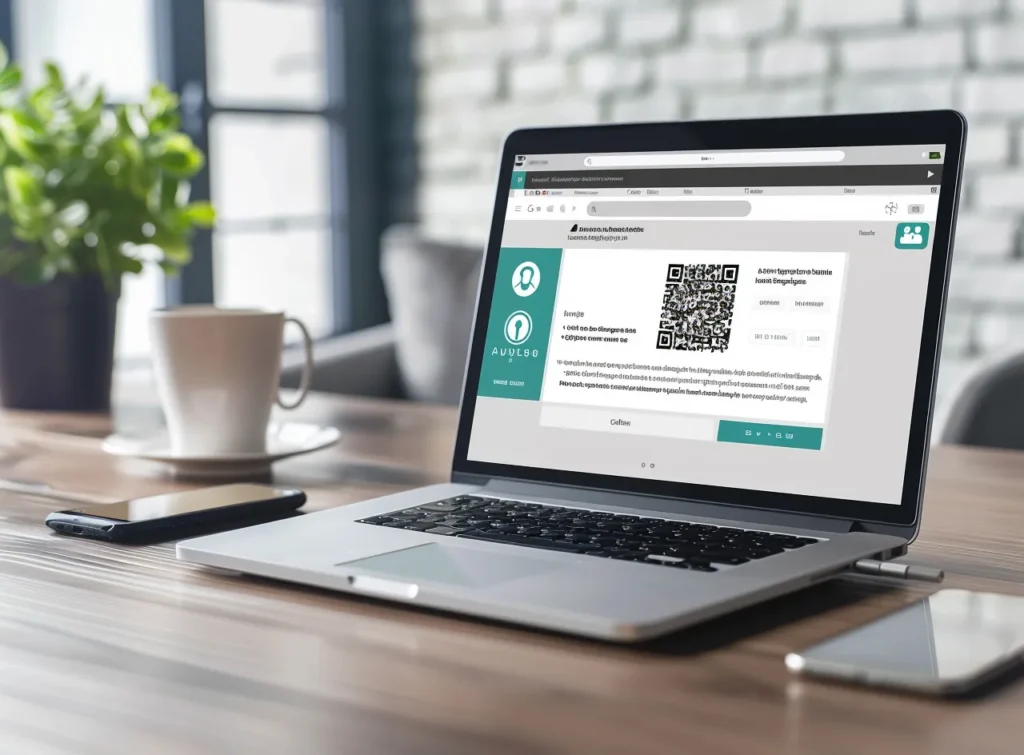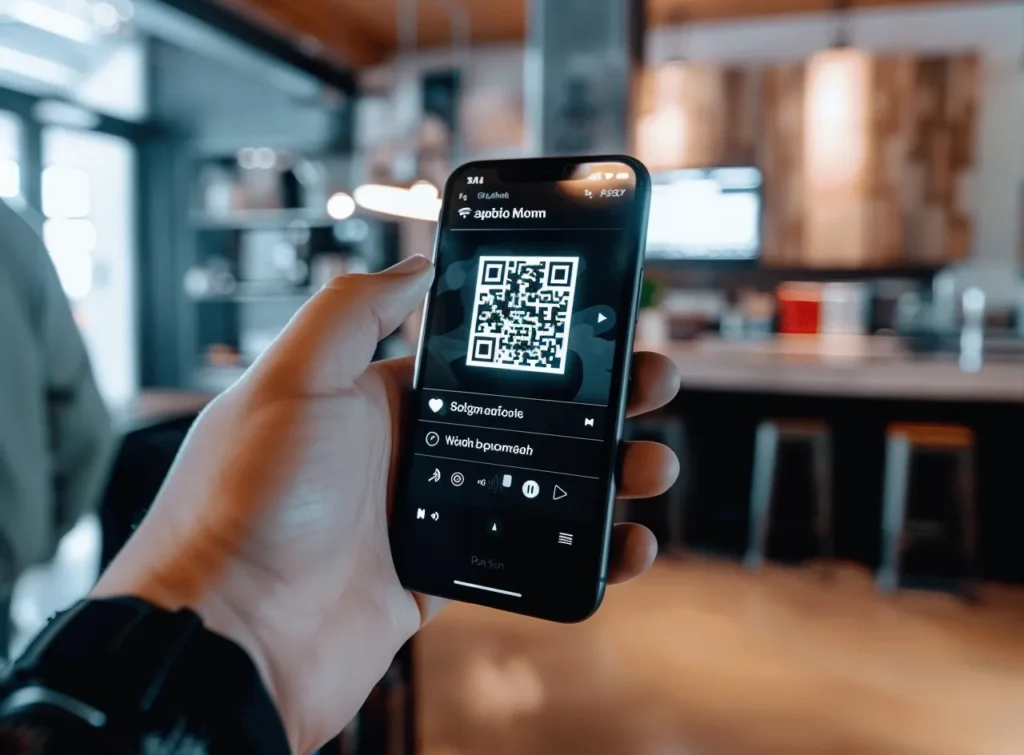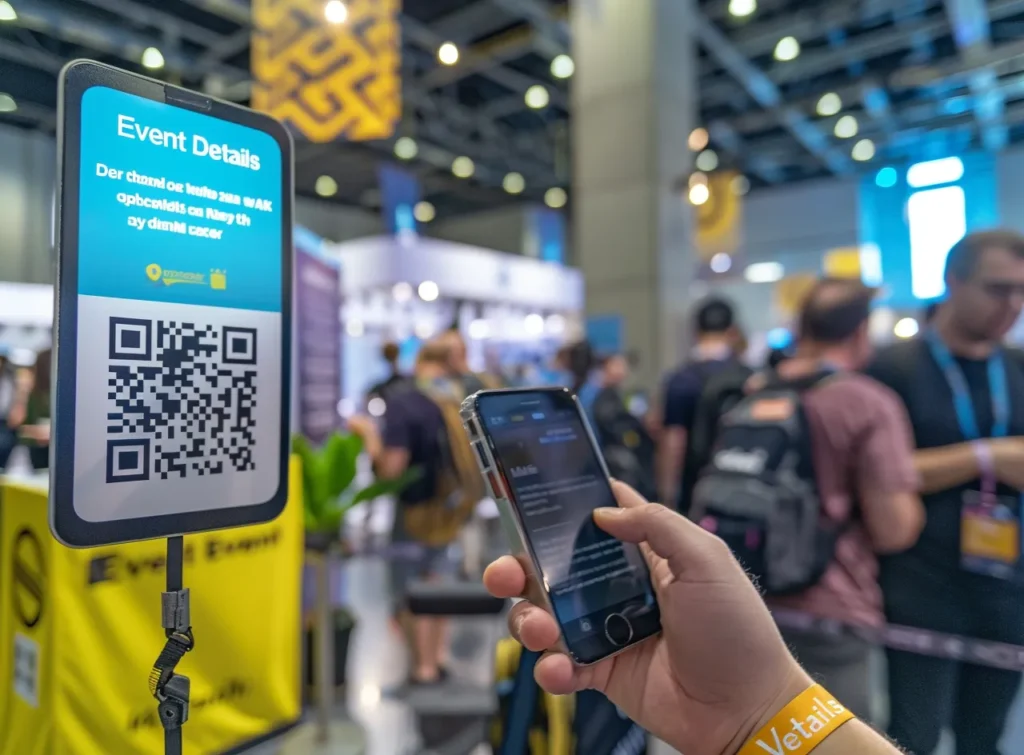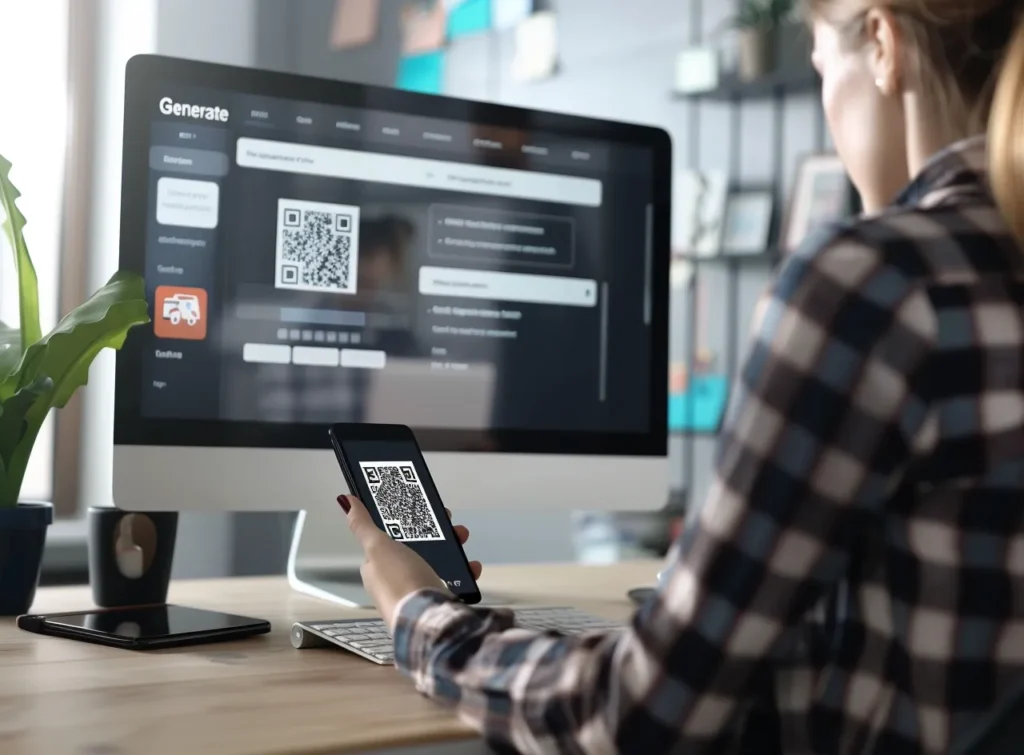Generate and Design Link QR Codes in Minutes
To generate a link QR code for use on social media, websites, flyers, and more, select the ‘AnyURL’ option, enter your web page link, and design your QR code to match your website or brand aesthetics.
How Can I Use a Link QR Code to Increase Engagement?
Link QR codes can be included on practically anything. Whether you’re sharing them on social media, including them on your website, or implementing them on a physical item, QR codes can transport users to your online content in a matter of seconds.
QR codes help to cut down the amount of time viewers manually search for your content on websites or social media. Plus, they’re excellent for quickly sharing important information with your audience.
Link QR codes are all about convenience. With a quick scan of a QR code, viewers are transported instantly to your link, and are able to access your content directly on their smartphone. Considering that a significant portion of web traffic comes from mobile devices, it’s a layer of convenience your audience is sure to appreciate.
- Incorporate QR codes in your print advertisements, such as magazines, newspapers, or posters. This allows potential customers to quickly access more information, special offers, or your online store, empowering and enriching the effectiveness of your print campaigns.
Boost Your Print Advertising
- Social media is the perfect place to share your link QR codes. Whether you’re a business using social media to connect with your customers, or you use it to keep up with friends or family, it’s the perfect platform to ensure that as many people as possible see your QR code. Especially when you consider that nearly 5 billion people across the world are on social media (DataReportal, 2024).
Share Your QR Code for Links on Social Media
- If you’re hosting an event, like a conference, workshop, or party, embedding QR codes on your invitations can help your attendees access event details, RSVP forms, or virtual event links.
Embed Your Link QR Code on Event Invitations
- Want to ensure your users get the most out of your content? Add a link QR code that takes them to resources, such as a help center, product manuals, or tutorials. This can be especially useful for providing instant access to important information.
Add a QR Code for Quick Access to Resources
How to Create a QR Code for a URL?
It is rather crucial to access internet items rapidly in the digital age of today. QR codes provide the incredibly simple connection of offline objects with internet information. Whether it’s leading customers to your website or providing direct links to promotional videos, QR codes for URLs simplify the digital journey. Follow these steps to create a QR code for a URL using MyQRCode:
- Navigate to My QR Code: Begin by visiting My QR Code and selecting the ‘Create QR code’ option.
- Select URL QR Code Type: Choose the ‘URL’ option as your preferred QR code type to link directly to a web page.
- Name Your QR Code: Assign a memorable name to your QR code for easy identification.
- Enter Your URL: Type in the web address you wish to link to your QR code. Ensure it’s correct to avoid any access issues.
- Customize Your QR Code: Personalize the appearance of your QR code by selecting colors, patterns, and frames that align with your brand or personal preference.
- Review and Generate: Double-check your entered information and design choices, then click ‘Finish’ to create your QR code.
My QR Code’s URL QR code generator is designed to accommodate up to 2048 characters, allowing you to link to almost any web page you desire. If your project demands more than just a simple URL link, My QR Code provides 11 other QR code options to explore, from embedding videos to linking social media profiles.
Recognizing the importance of mobile accessibility, My QR Code ensures its platform is fully optimized for smartphone use. With over half of global web traffic originating from mobile devices, creating and scanning QR codes on-the-go is more than a convenience—it’s a necessity. For desktop users, MyQRCode offers a streamlined dashboard where creating a QR code is just as effortless, complete with analytics tools to track engagement.

QR Code Encoding Standards
Each QR code must follow a ‘standard’ for the information encoded within it. This is mostly set by the International Organization for Standardization (ISO). They make rulings around aspects like the shapes and forms that QR codes can take, and the functional elements that must be included. There are different encoding standards for different digital activities, including:
- URL QR Codes
- vCard QR Codes
- PDF QR Codes
- WiFi QR Codes
That’s why you might notice a few subtle differences between different QR codes. Please note, however, this is more to do with the way the functional elements are laid out and the overall shape of a QR code. My QR Code allows users to change design aspects of QR codes like colors, QR patterns, corner squares, and borders, all while sticking within ISO standards.
What Can You Do with a URL QR Code?
MyQRCode’s URL QR codes can encode a wide variety of online destinations:
- Direct to Websites: Lead users straight to your homepage or specific landing pages.
- Promote Events: Link to online event pages or registration forms.
- Share Multimedia: Connect audiences to music, videos, or galleries.
- Educate and Inform: Provide direct access to blogs, research, or educational materials.
Beyond these examples, My QR Code encourages creativity in using URL QR codes to support business strategies, enhance educational projects, or simply share interesting content with friends and family.
My QR Code’s URL QR codes offer a flexible way to connect with a wide range of online content, from directing users to specific websites and promoting events, to sharing multimedia and providing educational materials. The flexibility and effectiveness of QR codes in driving web traffic and enhancing user engagement are well-documented.
For instance, Statista (2023) reports a notable increase in QR code interactions, with a significant percentage of smartphone users scanning a QR code to access information online at least once in the past year. This trend underscores the growing reliance on QR codes for a variety of purposes, from business promotions to educational access, reflecting their potential to significantly boost online engagement and information dissemination across various sectors.
Reinforcing Projects with URL QR Codes
URL QR codes from My QR Code can uplift your initiatives by:
- Boosting Engagement: Drive traffic directly to your digital content with a simple scan. According to a recent survey by ResearchGate (2023), QR code usage can increase online engagement, showcasing their effectiveness in attracting audience attention.
- Simplifying Access: Remove the barriers between your audience and your online resources. Studies have found that QR codes reduce the time it takes for users to access information by 50%, making it easier for them to reach the content they’re interested in.
- Measuring Impact: Feel free to use My QR Code’s analytics to gauge the effectiveness of your QR codes in real-time. Businesses report a notable improvement in understanding customer behavior through the use of QR code analytics (ResearchGate, 2024), enabling more targeted and efficient marketing strategies.
Security and Privacy of URL QR Codes
Not to worry, URL QR codes created with MyQRCode are secure. Users have full control over the content their QR code links to, with the ability to update or deactivate it as needed. Regular security audits and adherence to data protection laws ensure your QR codes are both safe and compliant.
My QR Code is committed to advancing how individuals and businesses connect with digital content. By integrating QR codes into your strategy, you’re not just keeping up with technology—you’re leveraging it to create more meaningful and accessible digital experiences.
QR Code Encoding Standards
Each QR code must follow a ‘standard’ for the information encoded within it. This is mostly set by the International Organization for Standardization (ISO). They make rulings around aspects like the shapes and forms that QR codes can take, and the functional elements that must be included. There are different encoding standards for different digital activities, including:
- URL QR Codes
- vCard QR Codes
- PDF QR Codes
- WiFi QR Codes
That’s why you might notice a few subtle differences between different QR codes. Please note, however, this is more to do with the way the functional elements are laid out and the overall shape of a QR code. My QR Code allows users to change design aspects of QR codes like colors, QR patterns, corner squares, and borders, all while sticking within ISO standards.
Expanding the Reach of Your Social Media Presence
In addition to directing users to websites and online content, URL QR codes can also be a powerful tool for boosting your social media presence. By linking your QR code to your social media profiles, you can make it easy for users to find and follow you on their preferred platforms. This can be especially useful for businesses looking to increase their social media engagement and build a stronger online community.
For example, you can create a QR code that links directly to your Instagram profile, allowing users to quickly and easily follow you and stay up-to-date on your latest posts. Similarly, you can link to your Twitter, Facebook, or LinkedIn profiles, providing users with a simple way to connect with you and stay informed about your latest news and updates.
By using the power of URL QR codes, you can expand the reach of your social media presence and make it easier for users to connect with you online. So why wait? Start creating URL QR codes today and take your social media strategy to the next level!

Why create a QR code for a URL?
Creating a QR code for a URL offers several distinct advantages over simply sharing a URL. Here are the key benefits and reasons why you should consider using QR codes:
1. Ease of Access
Quick Scanning: QR codes allow users to access your URL with a simple scan, eliminating the need to manually type out long and complicated URLs. This is especially useful for mobile users who can scan the code with their smartphone camera.
2. Enhanced and Enriched User Experience
Instant Redirection: Users are immediately redirected to the desired content, providing a seamless experience. This instant access can significantly improve user engagement and satisfaction.
3. Versatility in Use
Physical and Digital Integration: QR codes can be placed on physical items like brochures, business cards, posters, and product packaging, as well as in digital formats on websites and social media. This flexibility allows you to reach a broader audience.
4. Increased Engagement
Interactive Content: By embedding QR codes in various marketing materials, you encourage interaction and engagement. Users are more likely to explore your content when it’s easily accessible through a quick scan.
5. Analytics and Tracking
Measure Success: Many QR code generators offer analytics features, allowing you to track how many people scan your codes, where they scanned from, and what devices they used. This data can help you measure the success of your campaigns and make informed decisions.
6. Branding Opportunities
Customizable Designs: QR codes can be customized with your brand colors, logo, and design elements. This not only enhances your brand’s visibility but also makes the QR code more appealing and trustworthy to users.
7. Security and Accuracy
Error-Free Access: QR codes reduce the risk of errors that can occur when manually typing URLs. This ensures that users reach the correct destination every time.

Practical Use Cases for Link/URL QR Codes
1. Boost Your Print Advertising
Incorporate QR codes in your print advertisements, such as magazines, newspapers, or posters. This allows potential customers to quickly access more information, special offers, or your online store, enhancing the effectiveness of your print campaigns.
2. Share Your QR Code for Links on Social Media
Social media is the perfect place to share your url QR codes. Whether you’re a business using social media to connect with your customers, or you use it to keep up with friends or family, it’s the perfect platform to ensure that as many people as possible see your QR code. Especially when you consider that nearly 5 billion people across the world are on social media (DataReportal, 2024).
3. Embed Your Link QR Code on Event Invitations
If you’re hosting an event, like a conference, workshop, or party, embedding QR codes on your invitations can help your attendees access event details, RSVP forms, or virtual event links.
4. Add a QR Code for Quick Access to Resources
Want to ensure your users get the most out of your content? Add a link QR code that takes them to resources, such as a help center, product manuals, or tutorials. This can be especially useful for providing instant access to important information.
By creating QR codes for URLs, you make it easier for your audience to engage with your content, track the effectiveness of your campaigns, and positively transform the overall user experience.

The QR Code Revolution for URLs: Why You Should Make the Switch
One-dimensional barcodes still have their place, especially in retail for pricing information. But they fall short when it comes to the digital world due to their limited storage capacity.
That’s where QR codes come in. These two-dimensional barcodes are everywhere now and can hold a lot more information, including URLs. In fact, according to MyQRCode (2024) statistics almost 50% of all QR code scans are for URLs, making them incredibly popular for connecting the physical and digital worlds.
QR codes offer a simple yet powerful way to link your physical marketing with your online content, helping you reach a broader audience. If you’re ready to dive into the world of QR codes, you’re in the right place. Here’s why creating a QR code with us is a smart move:
- Boost Engagement: QR codes make it easy for people to connect with your digital content, enhancing engagement and interaction with your brand.
- Easy Integration: They instantly bridge offline and online marketing, providing a smooth and consistent brand experience.
- Versatile Uses: QR codes can be used on product packaging, business cards, posters, and more, driving traffic to your website or social media.
- Insightful Analytics: Track how your QR codes are performing with our detailed analytics, helping you optimize user engagement.
- User-Friendly: Our service makes creating and managing QR codes quick and easy, so you can focus on what matters most.
Switch to QR codes today and see how they can transform your marketing efforts!